TOYOTA PRIUS C 2020 Manual PDF
Manufacturer: TOYOTA, Model Year: 2020, Model line: PRIUS C, Model: TOYOTA PRIUS C 2020Pages: 600, PDF Size: 12.02 MB
Page 71 of 600
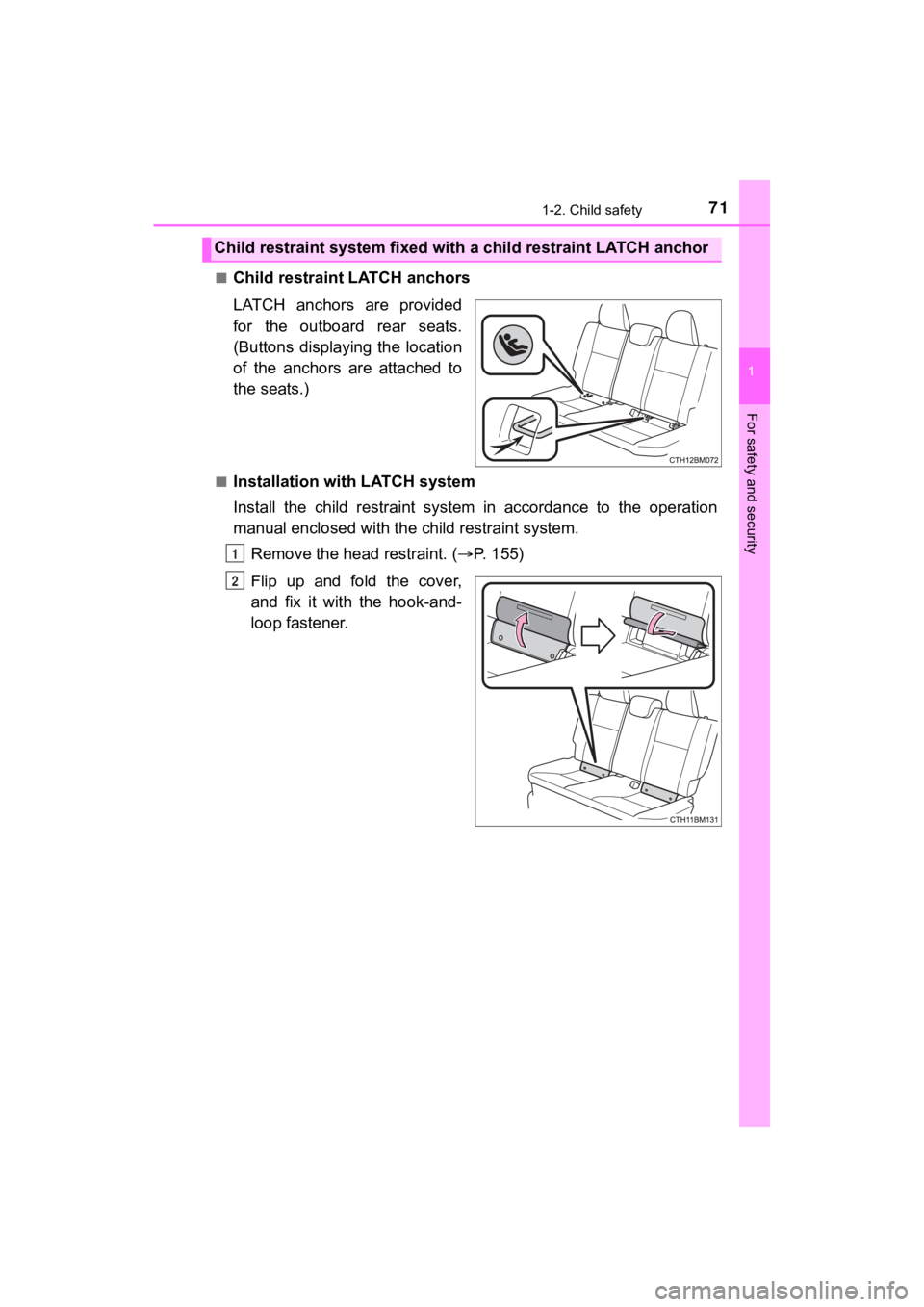
711-2. Child safety
1
For safety and security
PRIUS c_U■
Child restraint LATCH anchors
LATCH anchors are provided
for the outboard rear seats.
(Buttons displaying the location
of the anchors are attached to
the seats.)
■Installation with LATCH system
Install the child restraint system in accordance to the operati
on
manual enclosed with the child restraint system.
Remove the head restraint. ( P. 155)
Flip up and fold the cover,
and fix it with the hook-and-
loop fastener.
Child restraint system fixed with a child restraint LATCH ancho r
1
2
Page 72 of 600
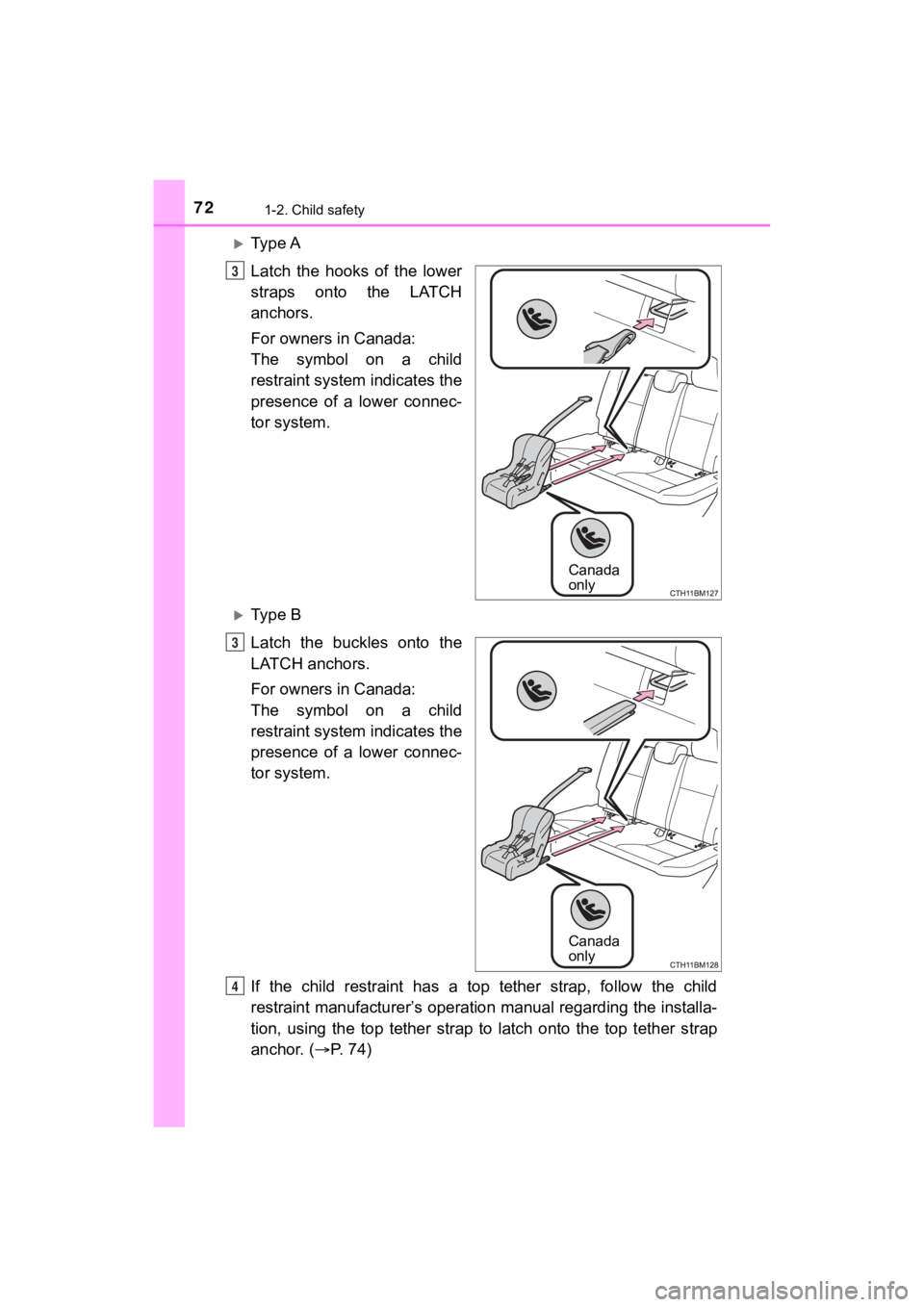
721-2. Child safety
PRIUS c_U
Ty p e A
Latch the hooks of the lower
straps onto the LATCH
anchors.
For owners in Canada:
The symbol on a child
restraint system indicates the
presence of a lower connec-
tor system.
Ty p e B
Latch the buckles onto the
LATCH anchors.
For owners in Canada:
The symbol on a child
restraint system indicates the
presence of a lower connec-
tor system.
If the child restraint has a top tether strap, follow the child
restraint manufacturer’s operation manual regarding the installa-
tion, using the top tether strap to latch onto the top tether s trap
anchor. ( P. 7 4 )
Canada
only
3
Canada
only
P
Q
Page 73 of 600
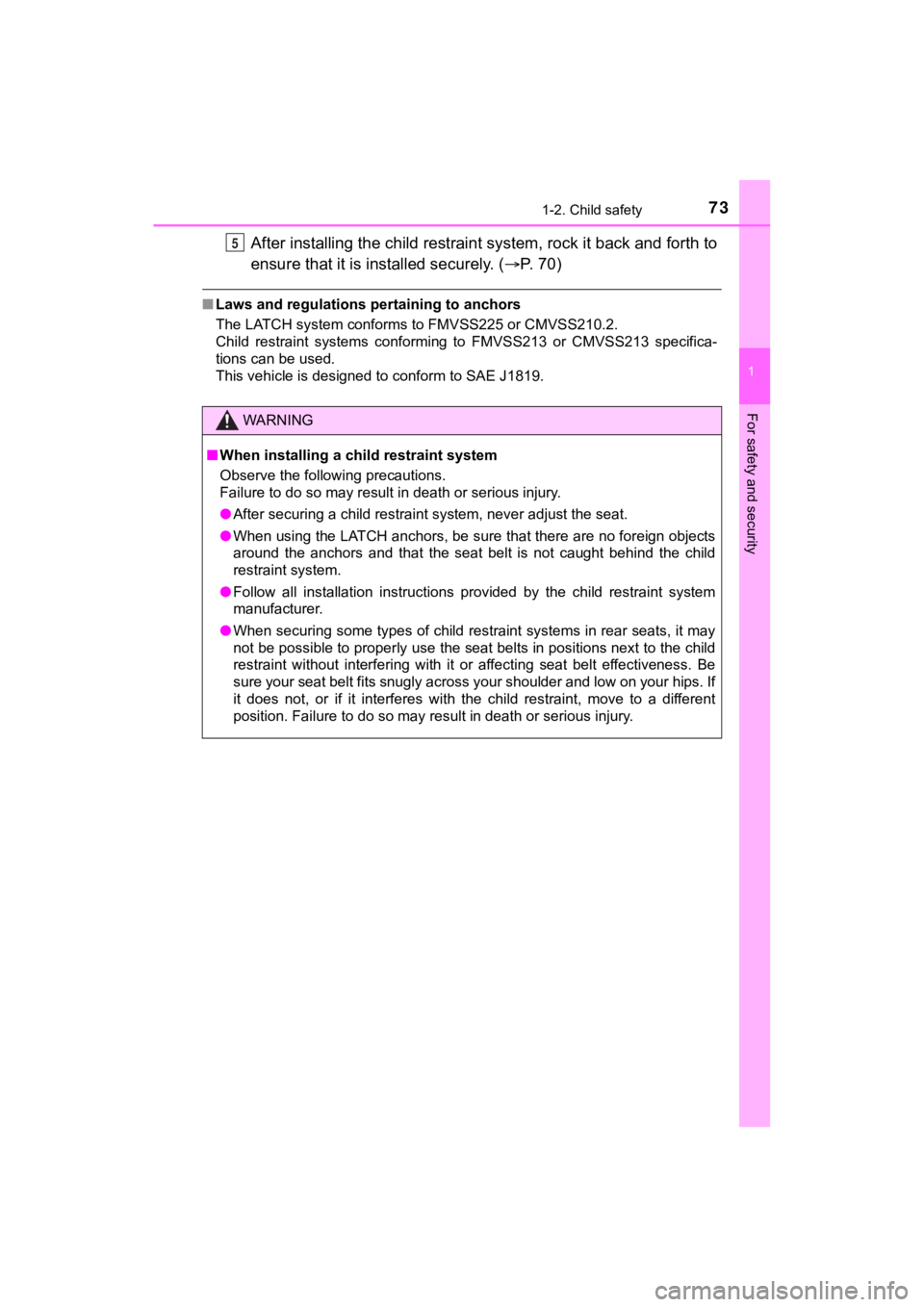
731-2. Child safety
1
For safety and security
PRIUS c_U
After installing the child restraint system, rock it back and forth to
ensure that it is in stalled securely. ( P. 70)
■Laws and regulations pertaining to anchors
The LATCH system conforms to FMVSS225 or CMVSS210.2.
Child restraint systems conforming to FMVSS213 or CMVSS213 spec ifica-
tions can be used.
This vehicle is designed to conform to SAE J1819.
WARNING
■ When installing a child restraint system
Observe the following precautions.
Failure to do so may result in death or serious injury.
● After securing a child restraint system, never adjust the seat.
● When using the LATCH anchors, be sure that there are no foreign objects
around the anchors and that the seat belt is not caught behind the child
restraint system.
● Follow all installation instructions provided by the child rest raint system
manufacturer.
● When securing some types of child restraint systems in rear seats, it may
not be possible to properly use the seat belts in positions next to the child
restraint without interfering with it or affecting seat belt ef fectiveness. Be
sure your seat belt fits snugly across your shoulder and low on your hips. If
it does not, or if it interferes with the child restraint, move to a different
position. Failure to do so may result in death or serious injur y.
5
Page 74 of 600
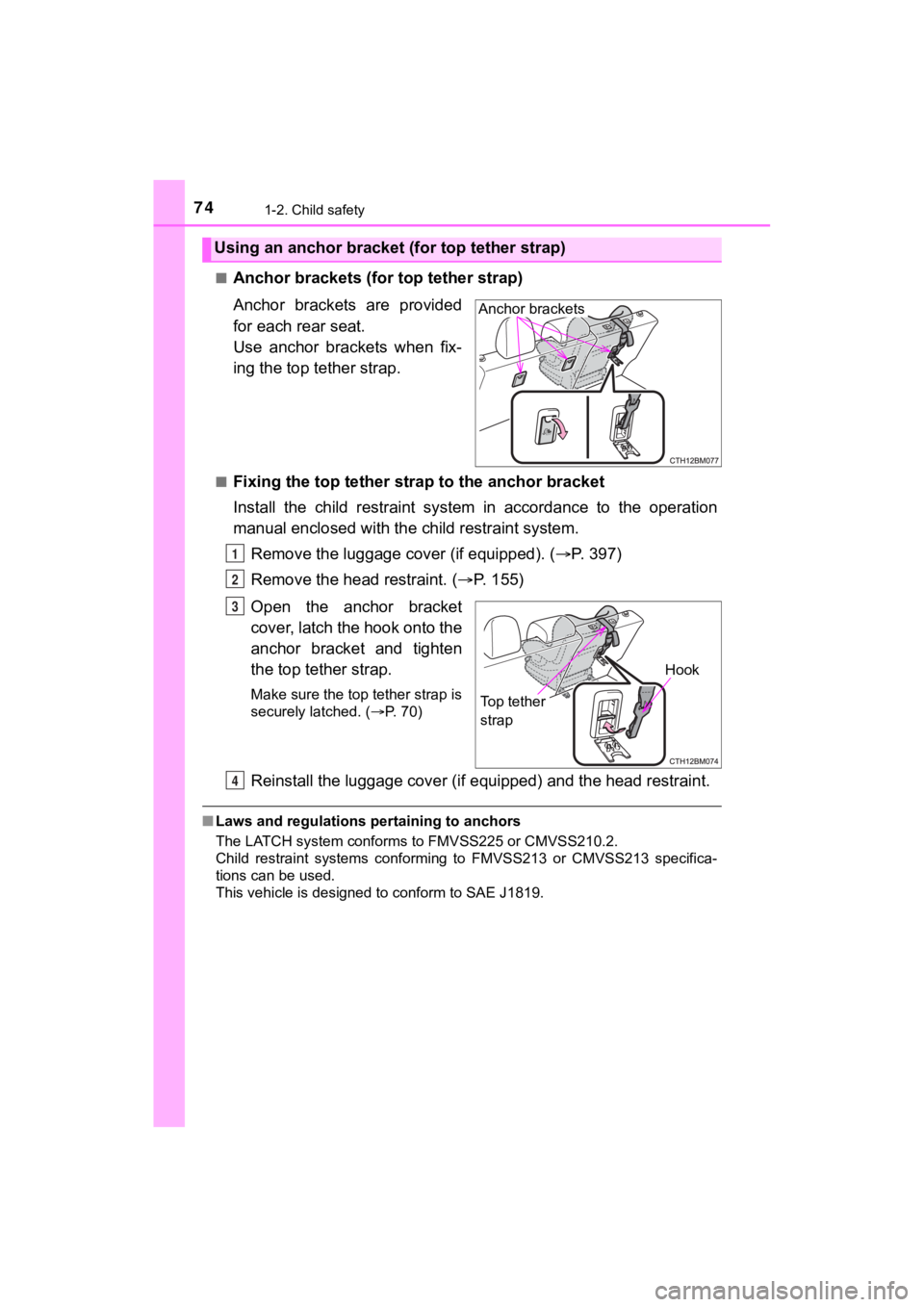
741-2. Child safety
PRIUS c_U■
Anchor brackets (for top tether strap)
Anchor brackets are provided
for each rear seat.
Use anchor brackets when fix-
ing the top tether strap.
■Fixing the top tether strap to the anchor bracket
Install the child restraint system in accordance to the operati
on
manual enclosed with the child restraint system.
Remove the luggage cover (if equipped). ( P. 3 9 7 )
Remove the head restraint. ( P. 155)
Open the anchor bracket
cover, latch the hook onto the
anchor bracket and tighten
the top tether strap.
Make sure the top tether strap is
securely latched. ( P. 70)
Reinstall the luggage cover (if equipped) and the head restrain t.
■Laws and regulations pertaining to anchors
The LATCH system conforms to FMVSS225 or CMVSS210.2.
Child restraint systems conforming to FMVSS213 or CMVSS213 spec ifica-
tions can be used.
This vehicle is designed to conform to SAE J1819.
Using an anchor bracket (for top tether strap)
Anchor brackets
1
2
Hook
Top tether
strap
P
Q
Page 75 of 600
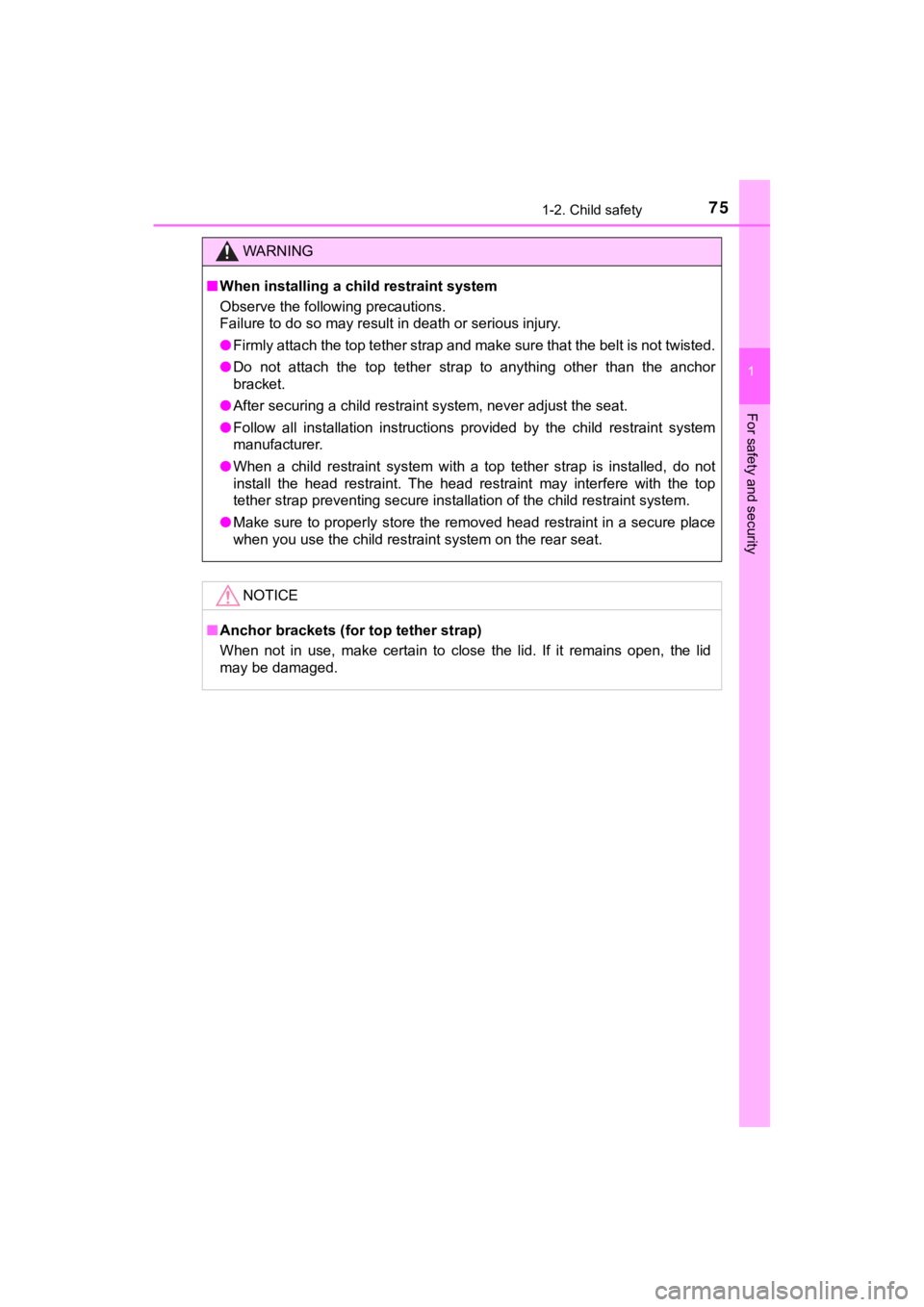
751-2. Child safety
1
For safety and security
PRIUS c_U
WARNING
■When installing a child restraint system
Observe the following precautions.
Failure to do so may result in death or serious injury.
● Firmly attach the top tether strap and make sure that the belt is not twisted.
● Do not attach the top tether strap to anything other than the anchor
bracket.
● After securing a child restraint system, never adjust the seat.
● Follow all installation instructions provided by the child rest raint system
manufacturer.
● When a child restraint system with a top tether strap is installed, do not
install the head restraint. The head restraint may interfere wi th the top
tether strap preventing secure installation of the child restraint system.
● Make sure to properly store the removed head restraint in a secure place
when you use the child restraint system on the rear seat.
NOTICE
■Anchor brackets (for top tether strap)
When not in use, make certain to close the lid. If it remains open, the lid
may be damaged.
Page 76 of 600
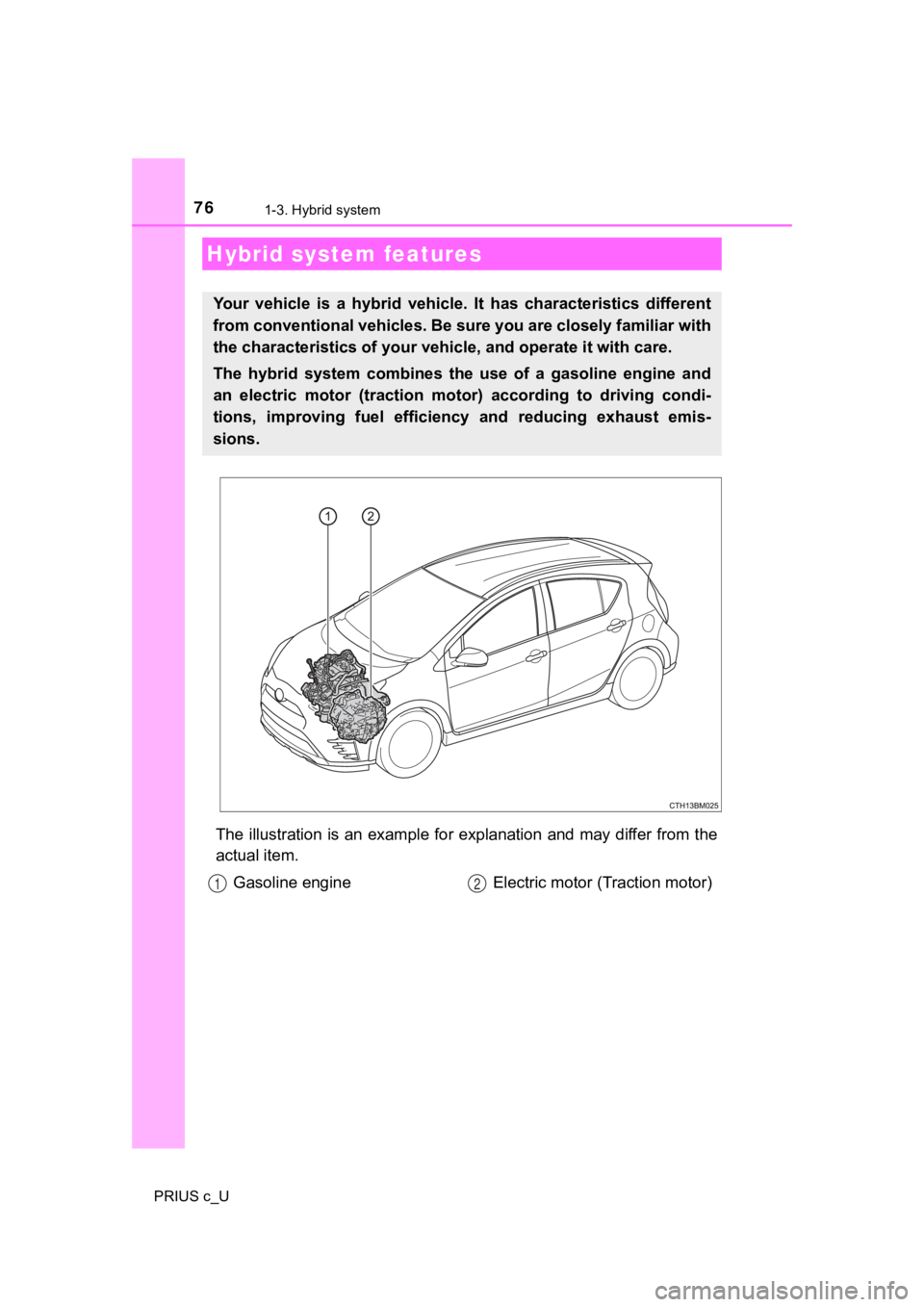
76
PRIUS c_U
1-3. Hybrid system
The illustration is an example for explanation and may differ from the
actual item.
Hybrid system features
Your vehicle is a hybrid vehicle. It has characteristics differ ent
from conventional vehicles. Be sure you are closely familiar wi th
the characteristics of your veh icle, and operate it with care.
The hybrid system combines the use of a gasoline engine and
an electric motor (traction motor) according to driving condi-
tions, improving fuel efficien cy and reducing exhaust emis-
sions.
Gasoline engine Electric motor (Traction motor)12
Page 77 of 600
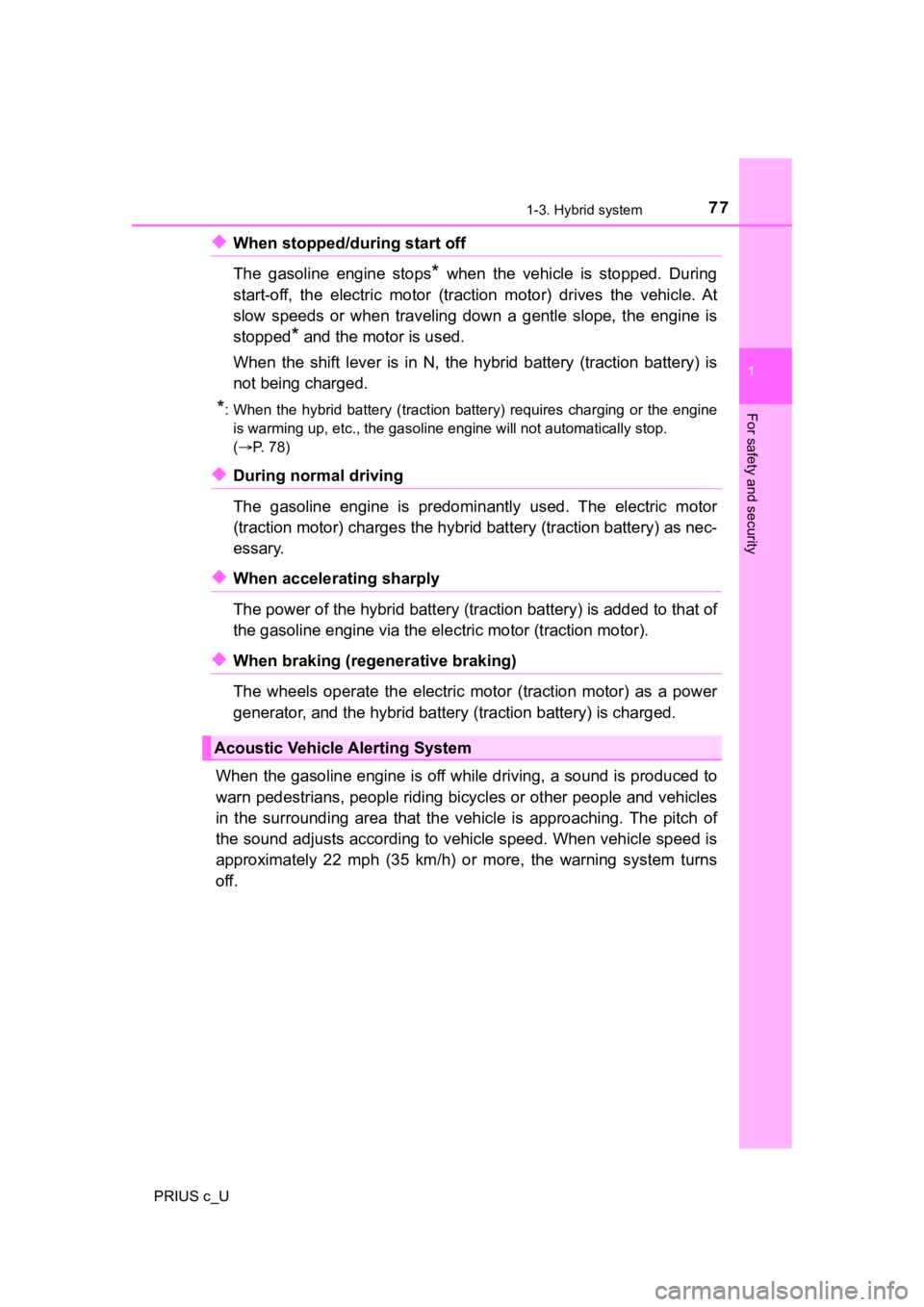
771-3. Hybrid system
1
For safety and security
PRIUS c_U
◆When stopped/during start off
The gasoline engine stops
* when the vehicle is stopped. During
start-off, the electric motor (traction motor) drives the vehic le. At
slow speeds or when traveling down a gentle slope, the engine i s
stopped
* and the motor is used.
When the shift lever is in N, the hybrid battery (traction batt ery) is
not being charged.
*: When the hybrid battery (traction battery) requires charging o r the engine
is warming up, etc., the gasoline engine will not automatically stop.
( P. 78)
◆During normal driving
The gasoline engine is predominantly used. The electric motor
(traction motor) charges the hybr id battery (traction battery) as nec-
essary.
◆When accelerating sharply
The power of the hybrid battery (traction battery) is added to that of
the gasoline engine via the ele ctric motor (traction motor).
◆When braking (regenerative braking)
The wheels operate the electric motor (traction motor) as a pow er
generator, and the hybrid battery (traction battery) is charged.
When the gasoline engine is off while driving, a sound is produ ced to
warn pedestrians, people riding bicycles or other people and ve hicles
in the surrounding area that the vehicle is approaching. The pi tch of
the sound adjusts according to v ehicle speed. When vehicle spee d is
approximately 22 mph (35 km/h) or more, the warning system turn s
off.
Acoustic Vehicle Alerting System
Page 78 of 600
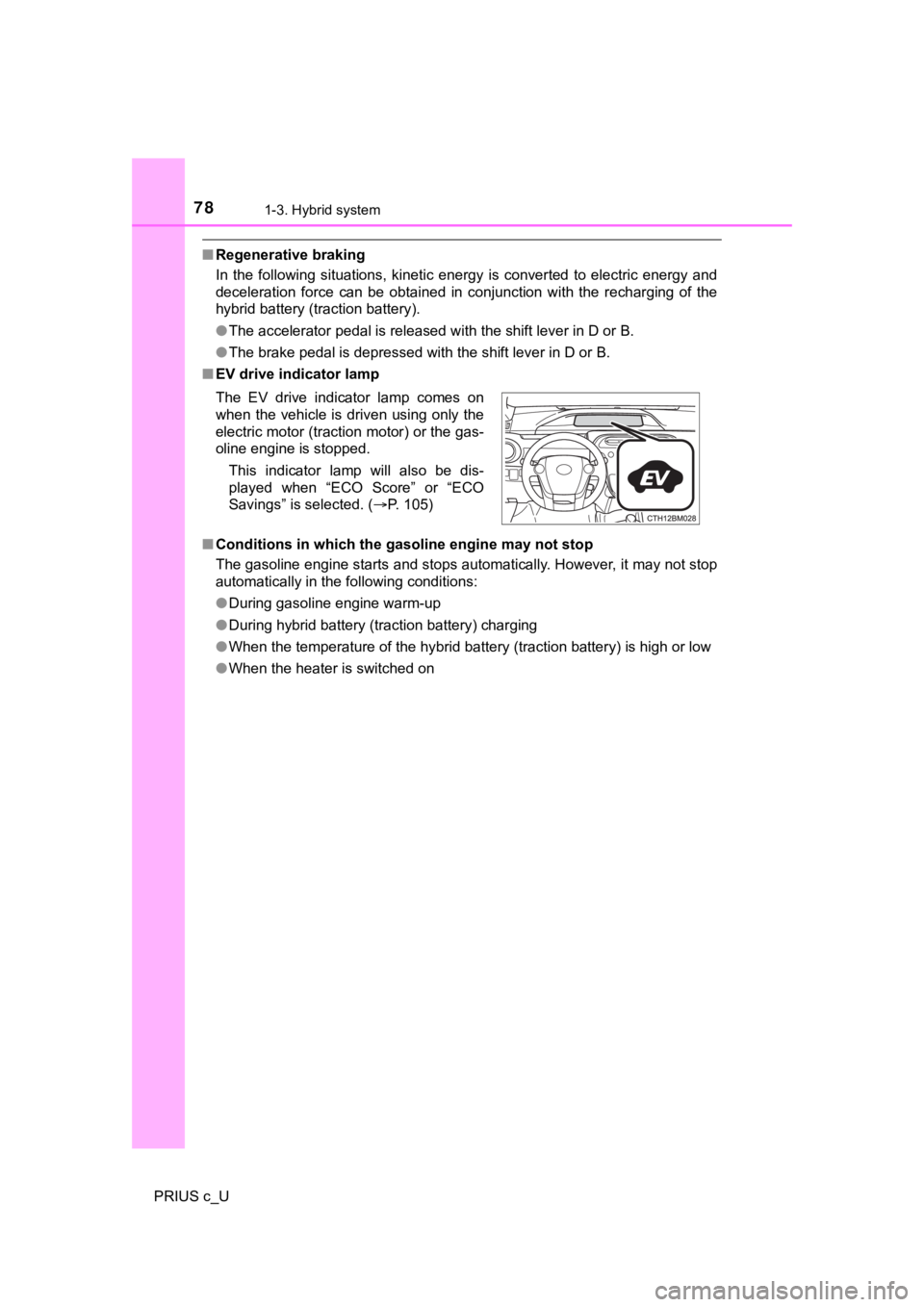
781-3. Hybrid system
PRIUS c_U
■Regenerative braking
In the following situations, kinetic energy is converted to electric energy and
deceleration force can be obtained in conjunction with the rech arging of the
hybrid battery (traction battery).
● The accelerator pedal is released with the shift lever in D or B.
● The brake pedal is depressed with the shift lever in D or B.
■ EV drive indicator lamp
■ Conditions in which the gasoline engine may not stop
The gasoline engine starts and stops automatically. However, it may not stop
automatically in the following conditions:
● During gasoline engine warm-up
● During hybrid battery (traction battery) charging
● When the temperature of the hybrid battery (traction battery) is high or low
● When the heater is switched on
The EV drive indicator lamp comes on
when the vehicle is driven using only the
electric motor (traction motor) or the gas-
oline engine is stopped.
This indicator lamp will also be dis-
played when “ECO Score” or “ECO
Savings” is selected. ( P. 105)
Page 79 of 600
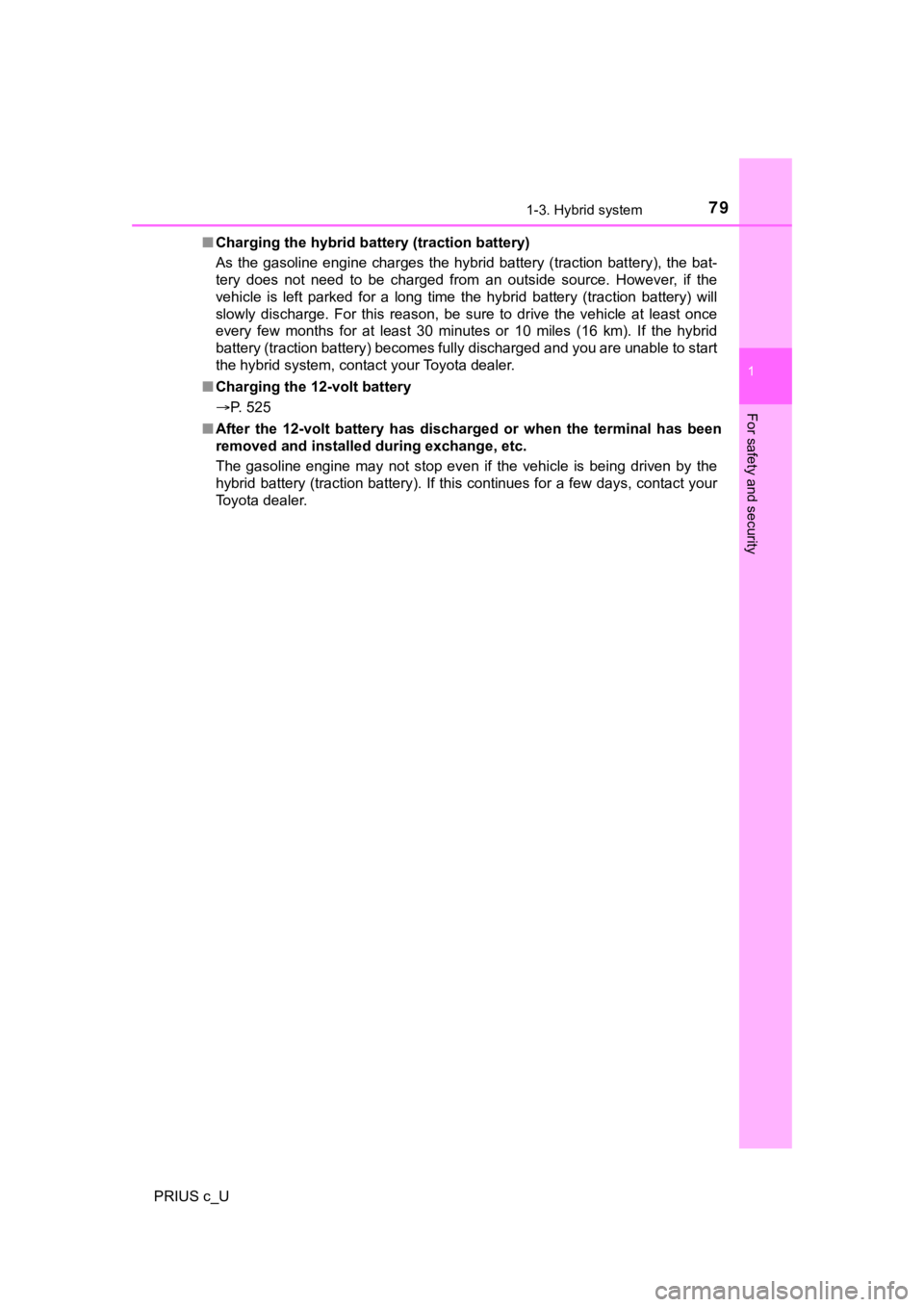
791-3. Hybrid system
1
For safety and security
PRIUS c_U■
Charging the hybrid batt ery (traction battery)
As the gasoline engine charges the hybrid battery (traction bat tery), the bat-
tery does not need to be charged from an outside source. Howeve r, i f t h e
vehicle is left parked for a long time the hybrid battery (trac tion battery) will
slowly discharge. For this reason, be sure to drive the vehicle at least once
every few months for at least 30 minutes or 10 miles (16 km). I f the hybrid
battery (traction battery) becomes fully discharged and you are unable to start
the hybrid system, contact your Toyota dealer.
■ Charging the 12-volt battery
P. 525
■ After the 12-volt battery has discharged or when the terminal h as been
removed and installed during exchange, etc.
The gasoline engine may not stop even if the vehicle is being driven by the
hybrid battery (traction battery). If this continues for a few days, contact your
Toyota dealer.
Page 80 of 600
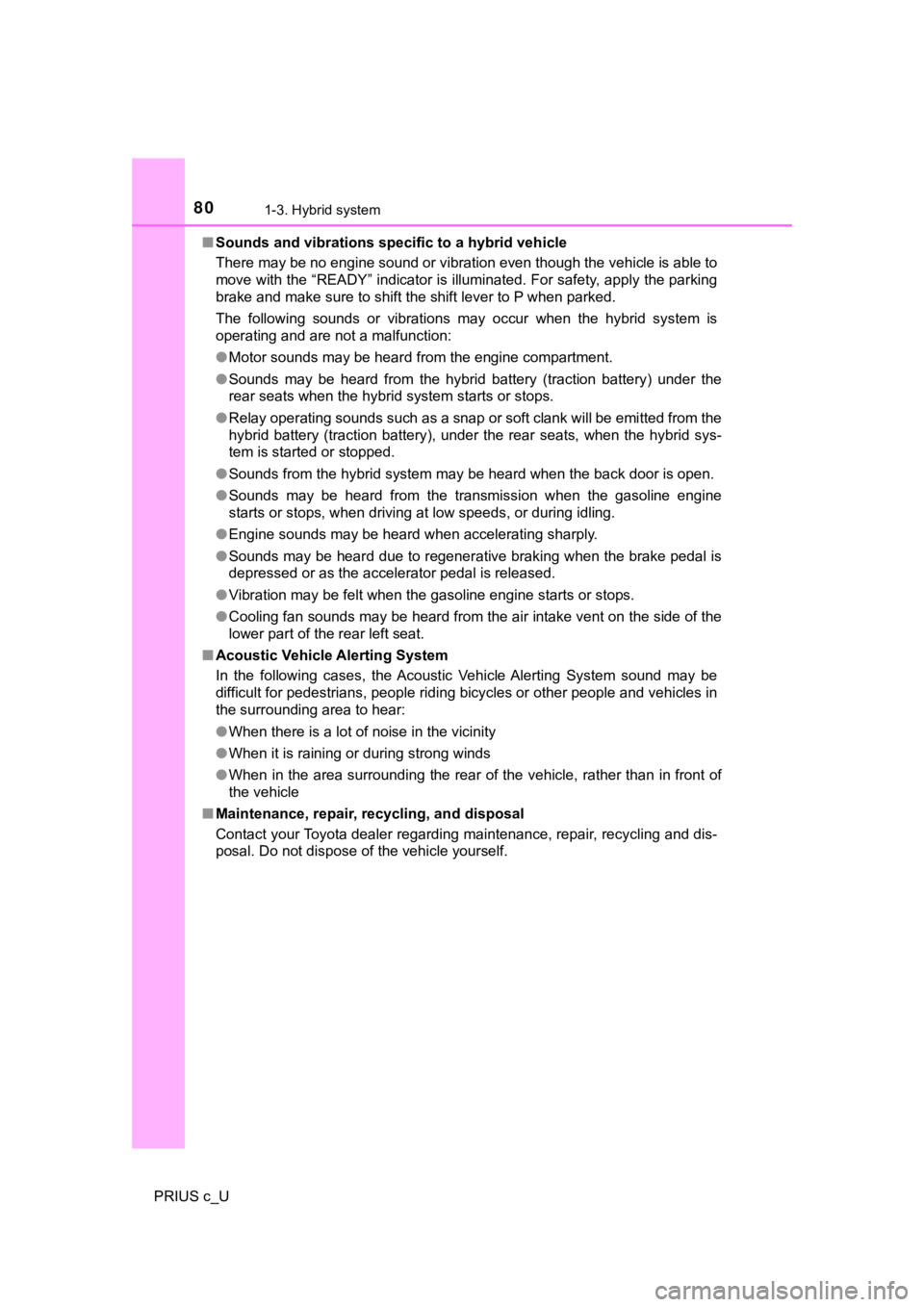
801-3. Hybrid system
PRIUS c_U■
Sounds and vibrations sp ecific to a hybrid vehicle
There may be no engine sound or vibration even though the vehic le is able to
move with the “READY” indicator is illuminated. For safety, app ly the parking
brake and make sure to shift the shift lever to P when parked.
The following sounds or vibrations may occur when the hybrid sy stem is
operating and are not a malfunction:
● Motor sounds may be heard from the engine compartment.
● Sounds may be heard from the hybrid battery (traction battery) under the
rear seats when the hybrid system starts or stops.
● Relay operating sounds such as a snap or soft clank will be emi tted from the
hybrid battery (traction battery), under the rear seats, when the hybrid sys-
tem is started or stopped.
● Sounds from the hybrid system may be heard when the back door is open.
● Sounds may be heard from the transmission when the gasoline engine
starts or stops, when driving at low speeds, or during idling.
● Engine sounds may be heard when accelerating sharply.
● Sounds may be heard due to regenerative braking when the brake pedal is
depressed or as the accelerator pedal is released.
● Vibration may be felt when the gasoline engine starts or stops.
● Cooling fan sounds may be heard from the air intake vent on the side of the
lower part of the rear left seat.
■ Acoustic Vehicle Alerting System
In the following cases, the Acoustic Vehicle Alerting System so und may be
difficult for pedestrians, people riding bicycles or other people and vehicles in
the surrounding area to hear:
● When there is a lot of noise in the vicinity
● When it is raining or during strong winds
● When in the area surrounding the rear of the vehicle, rather than in front of
the vehicle
■ Maintenance, repair, recycling, and disposal
Contact your Toyota dealer regarding maintenance, repair, recyc ling and dis-
posal. Do not dispose of the vehicle yourself.